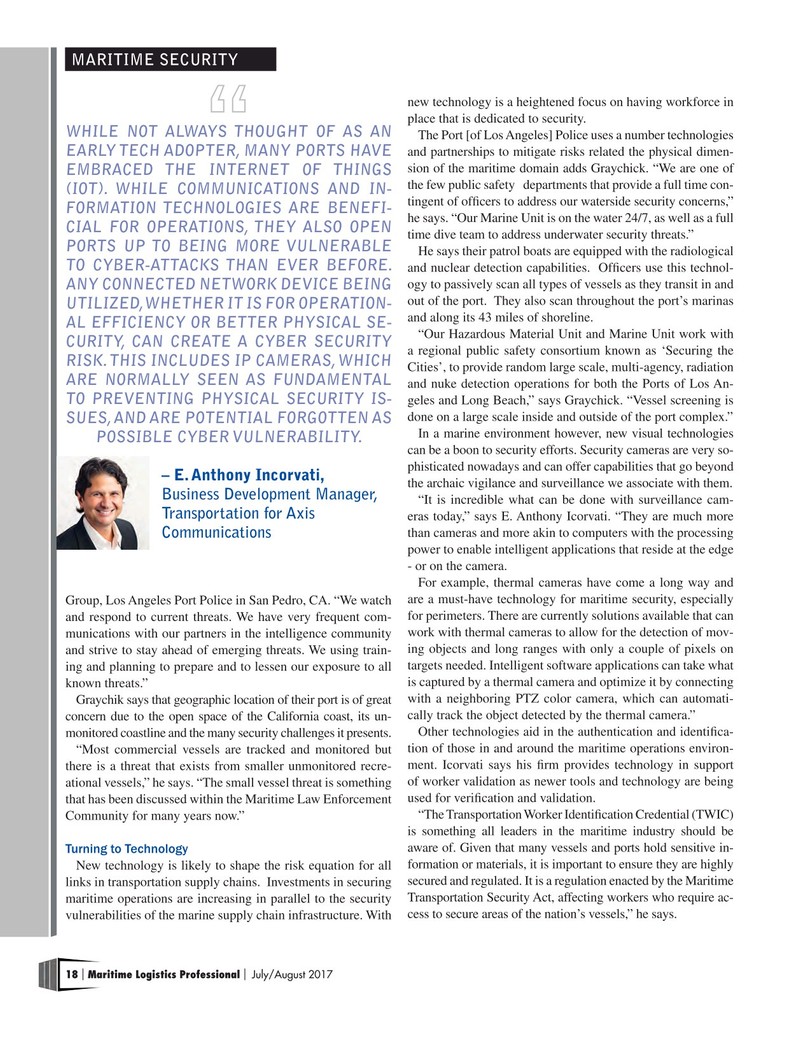
Page 18: of Maritime Logistics Professional Magazine (Jul/Aug 2017)
PORTS & INFRASTRUCTURE
Read this page in Pdf, Flash or Html5 edition of Jul/Aug 2017 Maritime Logistics Professional Magazine
MARITIME SECURITY new technology is a heightened focus on having workforce in place that is dedicated to security.
WHILE NOT ALWAYS THOUGHT OF AS AN
The Port [of Los Angeles] Police uses a number technologies and partnerships to mitigate risks related the physical dimen-
EARLY TECH ADOPTER, MANY PORTS HAVE sion of the maritime domain adds Graychick. “We are one of
EMBRACED THE INTERNET OF THINGS the few public safety departments that provide a full time con- (IOT). WHILE COMMUNICATIONS AND IN- tingent of offcers to address our waterside security concerns,”
FORMATION TECHNOLOGIES ARE BENEFI- he says. “Our Marine Unit is on the water 24/7, as well as a full
CIAL FOR OPERATIONS, THEY ALSO OPEN time dive team to address underwater security threats.”
PORTS UP TO BEING MORE VULNERABLE
He says their patrol boats are equipped with the radiological
TO CYBER-ATTACKS THAN EVER BEFORE. and nuclear detection capabilities. Offcers use this technol- ogy to passively scan all types of vessels as they transit in and
ANY CONNECTED NETWORK DEVICE BEING out of the port. They also scan throughout the port’s marinas
UTILIZED, WHETHER IT IS FOR OPERATION- and along its 43 miles of shoreline.
AL EFFICIENCY OR BETTER PHYSICAL SE- “Our Hazardous Material Unit and Marine Unit work with
CURITY, CAN CREATE A CYBER SECURITY a regional public safety consortium known as ‘Securing the
RISK. THIS INCLUDES IP CAMERAS, WHICH
Cities’, to provide random large scale, multi-agency, radiation
ARE NORMALLY SEEN AS FUNDAMENTAL and nuke detection operations for both the Ports of Los An-
TO PREVENTING PHYSICAL SECURITY IS- geles and Long Beach,” says Graychick. “Vessel screening is done on a large scale inside and outside of the port complex.”
SUES, AND ARE POTENTIAL FORGOTTEN AS
In a marine environment however, new visual technologies
POSSIBLE CYBER VULNERABILITY.
can be a boon to security efforts. Security cameras are very so- phisticated nowadays and can offer capabilities that go beyond – E. Anthony Incorvati, the archaic vigilance and surveillance we associate with them.
Business Development Manager, “It is incredible what can be done with surveillance cam-
Transportation for Axis eras today,” says E. Anthony Icorvati. “They are much more than cameras and more akin to computers with the processing
Communications power to enable intelligent applications that reside at the edge - or on the camera.
For example, thermal cameras have come a long way and
Group, Los Angeles Port Police in San Pedro, CA. “We watch are a must-have technology for maritime security, especially and respond to current threats. We have very frequent com- for perimeters. There are currently solutions available that can munications with our partners in the intelligence community work with thermal cameras to allow for the detection of mov- and strive to stay ahead of emerging threats. We using train- ing objects and long ranges with only a couple of pixels on ing and planning to prepare and to lessen our exposure to all targets needed. Intelligent software applications can take what known threats.” is captured by a thermal camera and optimize it by connecting
Graychik says that geographic location of their port is of great with a neighboring PTZ color camera, which can automati- concern due to the open space of the California coast, its un- cally track the object detected by the thermal camera.” monitored coastline and the many security challenges it presents. Other technologies aid in the authentication and identifca- “Most commercial vessels are tracked and monitored but tion of those in and around the maritime operations environ- there is a threat that exists from smaller unmonitored recre- ment. Icorvati says his frm provides technology in support ational vessels,” he says. “The small vessel threat is something of worker validation as newer tools and technology are being that has been discussed within the Maritime Law Enforcement used for verifcation and validation.
Community for many years now.” “The Transportation Worker Identifcation Credential (TWIC) is something all leaders in the maritime industry should be
Turning to Technology aware of. Given that many vessels and ports hold sensitive in-
New technology is likely to shape the risk equation for all formation or materials, it is important to ensure they are highly links in transportation supply chains. Investments in securing secured and regulated. It is a regulation enacted by the Maritime maritime operations are increasing in parallel to the security Transportation Security Act, affecting workers who require ac- vulnerabilities of the marine supply chain infrastructure. With cess to secure areas of the nation’s vessels,” he says.
18 Maritime Logistics Professional July/August 2017 | |

 17
17

 19
19
